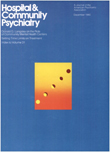Use of Inpatient Seclusion at a Community Mental Health Center
Abstract
Little research has been done on the use of seclusion in community mental health centers. The authors studied 56 seclusion room placements for 25 inpatients at a community mental health center and found that use of seclusion may more frequently be a function of staff than of patient need. Evening and night shifts made more frequent use of seclusion than did day shifts. Shifts staffed primarily with female employees used seclusion more than shifts where male staff predominated. Shifts with both a low staff-patient ratio and a larger number of female staff tended to use seclusion the most. The authors urge other CMHCs to critically examine their seclusion practices to ensure that they are humane and appropriate.
Access content
To read the fulltext, please use one of the options below to sign in or purchase access.- Personal login
- Institutional Login
- Sign in via OpenAthens
- Register for access
-
Please login/register if you wish to pair your device and check access availability.
Not a subscriber?
PsychiatryOnline subscription options offer access to the DSM-5 library, books, journals, CME, and patient resources. This all-in-one virtual library provides psychiatrists and mental health professionals with key resources for diagnosis, treatment, research, and professional development.
Need more help? PsychiatryOnline Customer Service may be reached by emailing [email protected] or by calling 800-368-5777 (in the U.S.) or 703-907-7322 (outside the U.S.).



